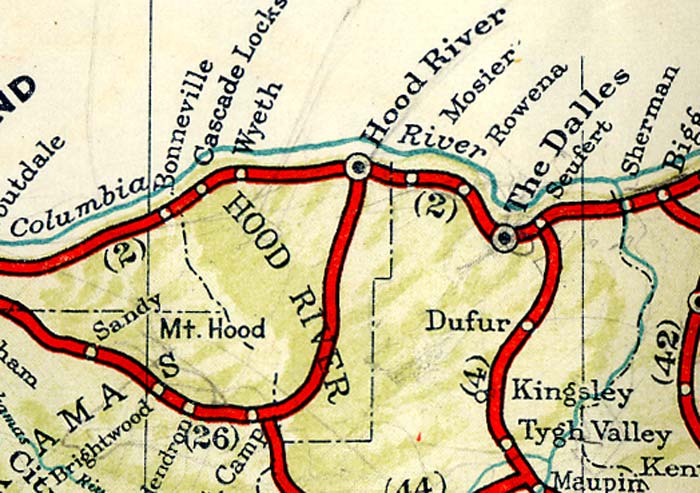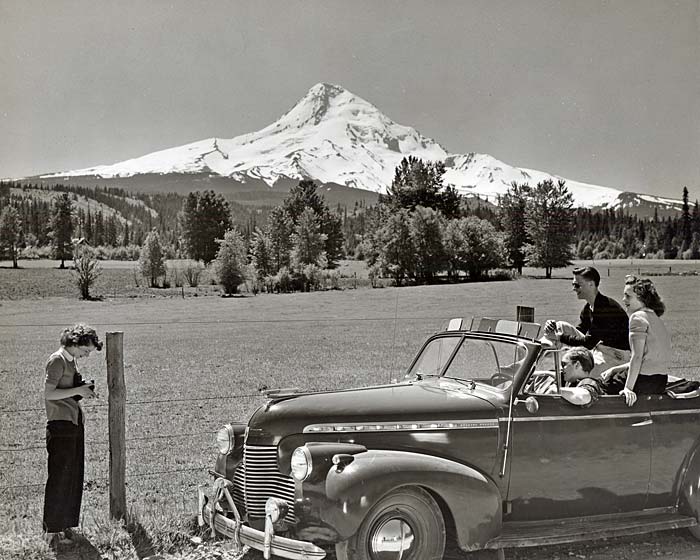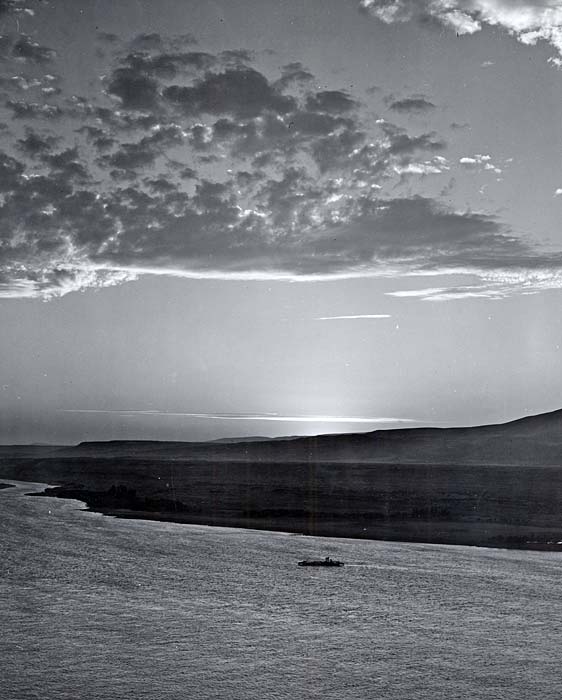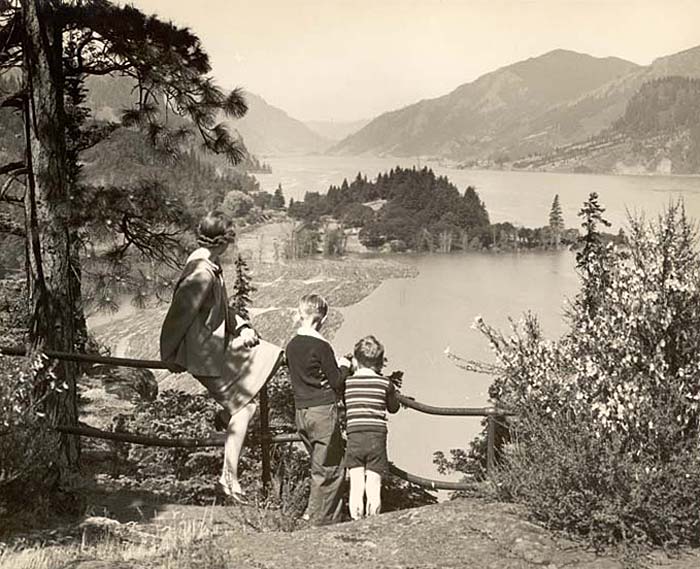 Section map (enlarge image).
Section map (enlarge image).
West of The Dalles US 30 follows the gorge of the Columbia River as it threads its way through the Cascade Range. Southwest towers Mount Hood, and northward across the Columbia Mount Adams. On some early maps these mountains are labeled the Presidents' Range, an attempt having been made in 1839 to use the names of chief executives to denominate the most prominent peaks.
West of ROWENA,
109.2 m. (148 alt., 60 pop.), the highway climbs the face of a steep cliff by a series of sharp curves and switch-backs known as the Rowena Loops.
Opposite Rowena, near LYLE, Wash., is the grave of Frederic Homer Balch (1861-1891), near that of his sweetheart, Genevra Whitcomb, whom he commemorated in his posthumously published novel,
Genevieve: A Tale of Oregon.
 Mt. Hood from Parkdale (2982).
Enlarge image.
Mt. Hood from Parkdale (2982).
Enlarge image.
ROWENA CREST,
111.8 m. (706 alt.), is in MAYER STATE PARK; parking place. From the crest is a panoramic view of cliff and winding river.
ROWENA DELL,
112.6 m., a sheer walled canyon (R) was infested by rattlesnakes until pioneers fenced the lower end and turned in a drove of hogs. Then for a time the dell was called Hog Canyon.
Memaloose View Point,
115.5 m., overlooks MEMALOOSE ISLAND, the "Island of the Dead," for hundreds of years an Indian burial place. Many of the bleached bones of generations of Indians have now been moved to other cemeteries along the Columbia, taken away from burial houses where they had been placed. A white marble shaft marks the grave of Victor Trevitt, an Oregon settler who asked that he be buried among his friends, the Indians.
MOSIER,
118.1 m. (95 alt., 192 pop.), at the confluence of Mosier Creek and the Columbia River, is in a small fruit growing section well known for its apple cider. The MOSIER TUNNELS,
119.5 m., one 261 feet and the other 60 feet long, often referred to as the Twin Tunnels, penetrate a promontory more than 250 feet above the river. West of this point the contrast between the barren, semi desert contours of eastern Oregon and the lushness of the Pacific Slope becomes apparent.
 Old Fort Dalles in The Dalles (3459).
Enlarge image.
Old Fort Dalles in The Dalles (3459).
Enlarge image.
At
124.6 m. is a junction with State 35.
US 30 crosses HOOD RIVER,
124.8 m., a glacier fed stream known in pioneer days as Dog River, a name said to have resulted from the adventure of an exploring party in early days who were compelled to eat dog meat to avert starvation. Lewis and Clark named the stream Labiche River for one of their followers.
HOOD RIVER,
125.6 m.(154 alt., 2,757 pop.).
Points of Interest: Historic Flag, Old Adams House, Apple growers' Association Warehouse, Apple growers' Association Cannery, Hood River Distilleries, Observation Promontory, Eliot Park.
The COLUMBIA GORGE HOTEL (R),
127.2 m., a large structure of striking lines, was built in 1921-22 by Simon Benson, pioneer lumberman. Just behind the hotel the picturesque WAW GUINGUIN FALLS drop over a sheer cliff to the river below. Nearby is the Crag Rats Clubhouse, owned by a mountain climbing organization having a membership limited to those who have climbed at least three major snow peaks; members must climb at least one major snow peak annually to remain in good standing.
 Twilight on the Columbia River (5841).
Enlarge image.
Twilight on the Columbia River (5841).
Enlarge image.
MITCHELL POINT TUNNEL (watch for traffic signals)
130.3 m., was bored through a cliff overhanging the river. In its 385-foot length are hewn five large arched windows overlooking the Columbia. The great projecting rock through which the bore was made was known among the Indians as Little Storm King, while the sky sweeping mountain above was called the Great Storm King.
The village of VIENTO (Sp.,
wind),
133.3 m. (103 alt., 14 pop.), is fittingly named, for the wind blows constantly and often violently through the gorge.
VIENTO STATE PARK (R),
133.4 m., is a wooded area that is popular as a picnic ground; through it runs scenic Viento Creek.
Starvation Creek empties into the Columbia at
134.5 m. Here is STARVATION CREEK STATE PARK, so named because at this point in 1884 an Oregon Washington Railroad & Navigation train was marooned for two weeks in thirty foot snowdrifts, and food was with difficulty carried to the starving passengers. Newspapers of the day gave columns of space to this story, telling how car seats were burned in addition to all coal in the locomotive tender, that passengers might be kept from freezing.
Near LINDSAY CREEK,
135.7 m., is a bronze plaque commemorating the commencement in 1912 the building of the first section of the Columbia River Highway. SHELL ROCK MOUNTAIN,
136.9 m. (2,068 alt.), is opposite WIND MOUNTAIN in Washington. The Indians believed the Great Spirit set the whirlwinds blowing in constant fury about Wind Mountain as a punishment to those who, breaking the taboo, taught white men to snare salmon.
 The Columbia River Gorge from the Columbia Gorge Hotel. (2491).
Enlarge image.
The Columbia River Gorge from the Columbia Gorge Hotel. (2491).
Enlarge image.
The Dalles and Sandy Wagon Road was authorized by the Oregon Legislature in 1867 and appropriation made for its construction. The road was built to a point 15 miles west of Hood River. Portions of the old dry masonry retaining wall may still be seen a hundred feet or so above the Columbia Highway, especially at Shell Rock Mountain.
COLUMBIA GORGE RANGER STATION,
142.8 m., is the headquarters of the MOUNT HOOD NATIONAL FOREST.
Left from the Columbia Gorge Ranger Station along the east fork of Herman Creek on Pacific Crest Trail through the heavy underbrush and pine growth of the Mount Hood National Forest. The trail mounts along the stream that pours its gleaming water in continuous cataracts, to CASEY CREEK (improved camp),
4 m. South of this point the route climbs the swelling base of MOUNT HOOD to GREEN POINT MOUNTAIN (improved campsites), 7 m. WAHTUM LAKE (improved camp),
12.5 m. (3,700 alt.), reflects the jagged crest line of dense pine forests.
 A group picnics at White River with Mt. Hood in the background (1187).
Enlarge image.
A group picnics at White River with Mt. Hood in the background (1187).
Enlarge image.
Continuing south the trail winds around the sharply rising shoulder of BUCK PEAK (4,768 alt.), to jewel like LOST LAKE,
22.5 m. (3,140 alt.). Mount Hood's white slopes seemingly lift from the yellow sands of the lake shore and the calm waters reflect the image. Although Lost Lake was viewed by the Indians with superstitious dread, its shores have long been a popular recreational area for white men. (Forest Guard Station; resort; bathing; boating; trout fishing.)
CASCADE LOCKS,
145.8 m. (120 alt., 1,000 pop.). Here in 1896 the Federal Government built a series of locks around the treacherous Cascades rapids. It is said by geologists that these rapids were caused by avalanches that slipped from the heights of Table Mountain impeding the free flow of the river.
 Skiing on Mt. Hood (g278).
Enlarge image.
Skiing on Mt. Hood (g278).
Enlarge image.
Skilled Indian paddlers or French Canadian boatmen were sometimes able to shoot the Cascade rapids successfully, particularly during spring freshets, but customarily even the most daring disembarked and portaged their cargoes. Prior to the building of the Barlow road in 1846 travelers seeking passage to the lower Columbia or Willamette Valleys halted at The Dalles, dismembered their wagons, loaded them on rafts, and steering the rude barges down the Columbia to the Cascades, docked at the Cascades and portaged wagons and goods around the dangerous white water. Ropes, used as shore lines, guided rafts to safety.
The Columbia River water route was popular both for passengers and freight, and a portage road was constructed in 1856 to accommodate traffic. Rather than following the water level, later used by the railroad portage, the original wagon road around the Cascades, climbed 425 feet, a steep ascent for the plodding oxen used to draw cumbersome wagons. Toll roads later permitted the passage of cattle and pack trains, but not until 1872 did the Oregon legislature make an appropriation to construct a road through the gorge. The present highway was developed from the narrow, crooked road built with that appropriation. A serious barrier to quantity freight transportation during the era when mining booms in Idaho and eastern Oregon made steamboat transportation on the Columbia a huge business, the Cascades were again mastered. This time at water level, by a wooden railed portage tramway over which mule drawn cars, laden with merchandise, rattled from one waiting steamer to another. This proved so profitable a venture that steel rails replaced the wooden ones, and the Oregon Pony, first steel locomotive to operate in Oregon and now on exhibition at the Union Station grounds in Portland, was imported to draw the cars. The importance of the Columbia River as a traffic artery being established, the locks were later built by the Federal Government. Nard Jones' novel,
Swift Flows the River, is based on the steamboat era of the Columbia centering about the Cascades.
The entrance (R) to the BRIDGE OF THE GODS is at
146 m., this is a cantilever toll bridge (cars, 50c; good for return within three hours) spanning the river just west of Cascade Locks, and occupies a place where, according to Indian legend, a natural bridge at one time arched the river. This bridge, they say, was cast into the river when Tyhee Sahale, the Supreme Being, became angry with his two sons, who quarreled over the beautiful Loo wit, guardian of a sacred flame on the bridge. The two sons and the girl, crushed in the destruction of the bridge, whose debris created the Cascades, were resurrected as Mount Hood, Mount Adams, and Mount St. Helens. This legend is used by Frederic Homer Balch in his romance,
The Bridge of the Gods.